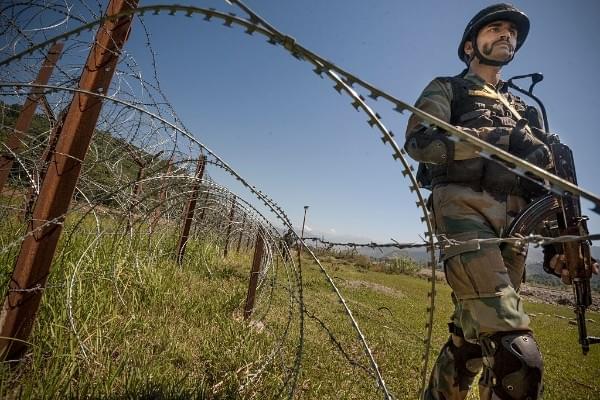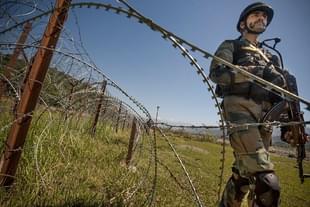Defence
In Trans-LOC Operations, An Offensive Game Plan Is Key
Syed Ata Hasnain
Dec 30, 2017, 09:57 AM | Updated Dec 29, 2017, 04:50 PM IST
Save & read from anywhere!
Bookmark stories for easy access on any device or the Swarajya app.


In 1983, I was deployed at a forward defended locality (FDL) in the Poonch sector as a company commander. It was a remote post surrounded on all sides by Pakistan-occupied Kashmir, where the Pakistan Army had an upper hand due to their deployment at a higher ground, and yet we kept them subdued due to intense engagement from well-concealed positions.
We kept the morale high through some sub-tactical-level psychological actions. Across the Betar Nala, I had a grandstand view of both Indian and Pakistani positions, rising up to the Raja Rani, which features the highest peaks on that part of the offshoot of the Pir Panjal; the area had seen intense fighting in both the 1965 and 1971 wars with Pakistan. The Line of Control (LOC) ran between two trees standing like twins and visible from far away; they were called “Bhai Bhai” in typical cryptic army humour. Close to Raja Rani was a forested feature where a Pakistani helipad existed, obviously the battalion headquarters of the Pakistani unit; it was called Rakh Chikri (“Rakh” means forest). The entire area had a thick forest cover.
On 25 December 2017, I was forced to mentally recall the lay of the ground again as this was the exact area of the 59 Baluch against whom an Indian unit of the famous Poonch Brigade carried out a local tactical action across the LOC, killing an officer and three jawans of the Pakistan Army. It was an act of retribution for the action carried out by the Pakistan Army at Keri against our troops, in which an officer and three bravehearts of 2 Sikh (Royal) were martyred.
The Indian action at Rakh Chikri was a tactical trans-LoC operation and not a surgical strike. The difference is essentially in the realm of objectives. In a surgical strike, specific objectives are chosen relating to the adversary’s infrastructure and locations, including terror camps, launch pads and training facilities, and the focus remains there; the distance could be deeper into the adversary’s ground. Any other operations conducted in adversary-held territory are incidental to the main operations.
In a local tactical operation, the penetration is comparatively shallow, but the number of troops could be comparable, operating as a number of small teams. They could be a mix of Special Forces and ghataks (commandos of the infantry units who are trained to a much higher degree of proficiency). The nature of operation is more akin to ambush, as routes of adversary patrols and logistics elements are well-known over the years. The Indian Army units are quite adept at these operations and can execute them without hiccups.
Pakistan chose to launch its operation against an Indian Army unit, 2 Sikh (Royal), in the Keri-defended area of the Rajouri sector, on 22 December 2017. A strike on the Kashmir LOC would have been much more difficult with the heavy snow conditions and missing foliage, which makes movement easier to discover. The Rajouri and Mendhar sectors are comparatively lower in altitude and in winter have the cover still reasonably intact. There are hundreds of such locations along the lower areas of the LOC south of the Pir Panjal, where there is enough broken ground through which infiltration is possible, and the LOC anti-infiltration fence runs close to the LOC. All these locations are patrolled by our troops for domination. The inevitable question should be why the strength of such patrols is small, making them vulnerable. The answer is that with the hundreds of responsibilities of troops at the LOC and the large number of such locations, there can only be a certain strength of troops available for patrolling the many gaps.
It also needs to be remembered that it is the Pakistan Army which has the initiative because it aids and abets in the infiltration of terrorists across the LOC. It also assists and in fact organises and leads Border Action Team (BAT) actions against our troops. The Indian Army has greater deployment, but it is more in responsive mode so as to counter infiltration and ensure the security of its posts. Much of the troop strength at our posts goes into these arduous tasks. Yet it cannot be denied that faster response systems and drills can assist in ensuring that the BAT cannot get away after having executed a task.
The answer lies in ensuring that the Indian Army sheds all qualms about conducting trans-LoC operations and any hesitation about the choice of objectives. If gloves have to be off, the ethics of LOC conflict may need to change. Already the Indian Army is dominating the exchanges of fire assault across the LOC. It only has to move up a few notches to shed inhibitions and prove that it can do one better than the Pakistan Army, a fact that it has proven in battle many a time.
I have conducted trans-LoC operations in my time when we were absolutely pressed to respond and can vouch that one strike would put the Pakistan Army into a shell and force it to become completely defensive. I have seen Pakistani FDLs lighting fires all night to illuminate areas around them because of the scare we imposed and psychological domination we achieved. To that extent, the swift decision of the government to give the Army’s Northern Command the green light to proceed and carry out retaliation for the criminal act that the Pakistan Army indulged in at Keri was most appropriate.
The choice of Rakh Chikri for the retribution did not surprise me. It is far removed from Keri (almost 120km away), in a higher part of an offshoot of the Pir Panjal range where the separation is reasonably large, offering scope for movement. The adversary would least have expected a response in an area higher up in the mountains due to snow conditions (December was usually a month during which Rakh Chikri was white-shod; not known whether the same is true today).
It is well-known that the LOC has become for Pakistan a convenient location for strategic messaging. When it is unable to achieve anything substantial in other domains, such as operations in the Valley or Jammu, it resorts to an odd BAT action. Due to infrequency in execution, the predictability factor remains low while surprise is high. Maintaining a high level of vigil 24 x 7 x 365 is virtually impossible for the best of forces; there will be chinks in the armour and human failings at some point. What the Indian Army needs as part of a transformation of conflict with Pakistan is greater proactivity and freedom to operate optimally to place its adversary under intense pressure.
The government does not appear to have placed shackles in the Army’s way, so it is up to its hierarchy to draw up a more offensive game plan. Ethics and qualms do not work here. There have been times the Indian Army has actually deliberately held back its offensive designs to allow the Pakistan Army to continue its counter-insurgency operations, for which troops from the LOC had also been withdrawn. We need to do the reverse so that a larger strength of the Pakistan Army is forced to return to the LOC and be on 24 x 7 vigil, awaiting Indian Army ghataks and Special Forces who could be behind it or on its flanks.
Lastly, Pakistan is adept at choreographing events and executing its tactical actions in sync with them. The visit of Kulbhushan Jadhav’s family and their humiliation comes in close coordination with the trans-LoC operation at Keri. It is this which needs to be defeated more substantially with greater predictability and better war-gaming.
The writer is a former GOC of India’s Srinagar based 15 Corps, now associated with Vivekanand International Foundation and the Institute of Peace and Conflict Studies.





